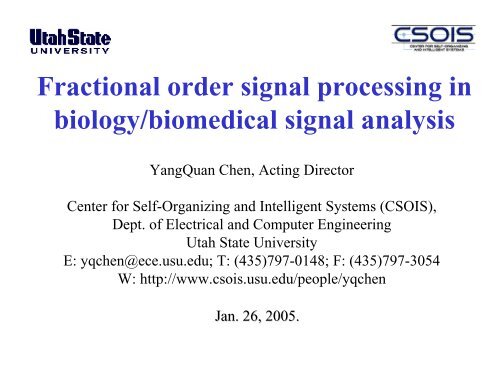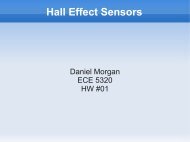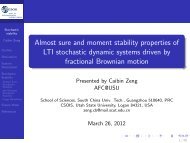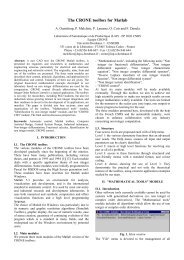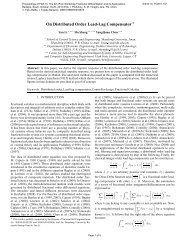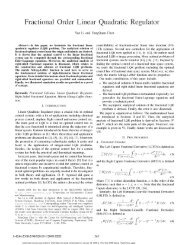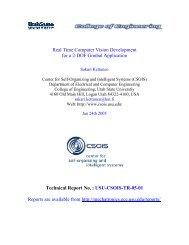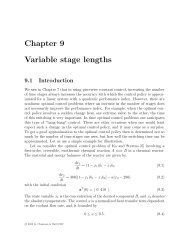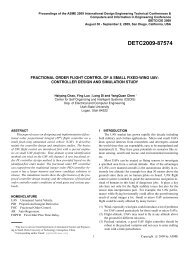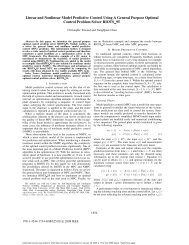Fractional order signal processing in biology/biomedical signal ...
Fractional order signal processing in biology/biomedical signal ...
Fractional order signal processing in biology/biomedical signal ...
You also want an ePaper? Increase the reach of your titles
YUMPU automatically turns print PDFs into web optimized ePapers that Google loves.
<strong>Fractional</strong> <strong>order</strong> <strong>signal</strong> <strong>process<strong>in</strong>g</strong> <strong>in</strong><br />
<strong>biology</strong>/<strong>biomedical</strong> <strong>signal</strong> analysis<br />
YangQuan Chen, Act<strong>in</strong>g Director<br />
Center for Self-Organiz<strong>in</strong>g and Intelligent Systems (CSOIS),<br />
Dept. of Electrical and Computer Eng<strong>in</strong>eer<strong>in</strong>g<br />
Utah State University<br />
E: yqchen@ece.usu.edu; T: (435)797-0148; F: (435)797-3054<br />
W: http://www.csois.usu.edu/people/yqchen<br />
Jan. 26, 2005.
Slide-2<br />
Comments<br />
• Jo<strong>in</strong>t work with Professor Anhong Zhou, BIE<br />
Dept. of USU.<br />
• Just some prelim. Results to show the potential<br />
4/19/2005 <strong>Fractional</strong> Order Calculus Day at Utah State University
Slide-3<br />
<strong>Fractional</strong> <strong>order</strong> <strong>signal</strong> <strong>process<strong>in</strong>g</strong><br />
techniques<br />
• <strong>Fractional</strong> differentiators/filters<br />
• <strong>Fractional</strong> <strong>in</strong>tegration: ARFIMA (autoregressive<br />
fractional <strong>in</strong>tegral mov<strong>in</strong>g average), or FARIMA<br />
• R/S Hurst exponent estimation<br />
• FD (fractional dimension) estimation<br />
• FrFT (fractional Fourier transform)<br />
4/19/2005 <strong>Fractional</strong> Order Calculus Day at Utah State University
Slide-4<br />
What is fractional <strong>order</strong> calculus?<br />
• FOC is a generalization of the<br />
differential and <strong>in</strong>tegral operators:<br />
• where α is the fractional <strong>order</strong> which<br />
can be a complex number and the<br />
constant a is related to the <strong>in</strong>itial<br />
conditions. Two commonly used<br />
def<strong>in</strong>itions, i.e., the Grünwald-<br />
Letnikov (GL) def<strong>in</strong>ition and the<br />
Riemann-Liouville (RL) def<strong>in</strong>ition:<br />
• where [•] is a floor<strong>in</strong>g-operator.<br />
4/19/2005 <strong>Fractional</strong> Order Calculus Day at Utah State University
Slide-5<br />
Why fractional <strong>order</strong> calculus?<br />
• Real world is fractional <strong>order</strong> <strong>in</strong> nature. The concept of fractional calculus has<br />
tremendous potential to change the way we see, model, and control the nature<br />
around us. In the past, the behavior of materials and systems were modeled us<strong>in</strong>g<br />
<strong>in</strong>teger <strong>order</strong> derivatives. It is now well known that many physical phenomena<br />
can be modeled accurately and effectively us<strong>in</strong>g fractional derivatives, whereas<br />
the <strong>in</strong>tegral derivative based models capture these phenomena only<br />
approximately. It has been demonstrated that many fractional derivatives based<br />
controls are far superior than <strong>in</strong>teger <strong>order</strong> derivative based control schemes.<br />
The concept of a real l<strong>in</strong>e was not complete until the concept of zero, rational,<br />
and irrational numbers was <strong>in</strong>troduced. Similarly, the concept of derivatives will<br />
not be complete until the concepts of fractional derivatives (or derivatives of<br />
arbitrary <strong>order</strong>) are brought <strong>in</strong>to the picture. Deny<strong>in</strong>g it will be like say<strong>in</strong>g that<br />
zero, fractional, and irrational numbers do not exist.<br />
4/19/2005 <strong>Fractional</strong> Order Calculus Day at Utah State University
Slide-6<br />
Detection of DNA hybridization on gold<br />
coated QCM surface<br />
• The work<strong>in</strong>g pr<strong>in</strong>ciple of QCM is based on the l<strong>in</strong>ear relationship between the<br />
change of frequency (∆f) and the change of mass on the crystal surface, as<br />
described <strong>in</strong> Suerbrey equation. In present work, the gold surface of QCM was<br />
immobilized with s<strong>in</strong>gle strand DNA (ssDNA) and subsequently hybridized with<br />
target DNA (tDNA). In addition to ∆f, resistance (R) was simultaneously<br />
recorded <strong>in</strong> the course of ssDNA immobilization and hybridization. 100 ml of<br />
water, control probe DNA, and target DNA were dropped onto the gold surface<br />
of quartz crystal <strong>in</strong> sequence and the time profiles of the response curves of ∆f<br />
and R were obta<strong>in</strong>ed respectively. It is <strong>in</strong>terest<strong>in</strong>g to observe the drastic<br />
oscillations of ∆f and R <strong>in</strong> the early period after add<strong>in</strong>g those three samples.<br />
Furthermore, <strong>in</strong> this paper, two fractional <strong>order</strong> <strong>signal</strong> <strong>process<strong>in</strong>g</strong> techniques,<br />
namely, fractional Fourier transform (FrFT) and rescaled range statistical<br />
analysis (R/S analysis), are applied to characterize the QCM <strong>signal</strong>s for easy<br />
differentiation of different cases studies <strong>in</strong> this research.<br />
4/19/2005 <strong>Fractional</strong> Order Calculus Day at Utah State University
Slide-7<br />
ARFIMA – def<strong>in</strong>ition of short and long memory process<br />
4/19/2005 <strong>Fractional</strong> Order Calculus Day at Utah State University
Slide-8<br />
4/19/2005 <strong>Fractional</strong> Order Calculus Day at Utah State University
Slide-9<br />
Fractal Dimensions<br />
• FD = <strong>in</strong>tr<strong>in</strong>sic dimensionality<br />
“Embedd<strong>in</strong>g” dimensionality = 3<br />
Intr<strong>in</strong>sic dimensionality = 1<br />
4/19/2005 <strong>Fractional</strong> Order Calculus Day at Utah State University
Slide-10<br />
Fractal Dimensions<br />
FD = <strong>in</strong>tr<strong>in</strong>sic dimensionality<br />
[Belussi/1995]<br />
Po<strong>in</strong>ts to note:<br />
• FD can be a non-<strong>in</strong>teger<br />
• There are fast methods<br />
to compute it<br />
log( # pairs)<br />
4/19/2005 <strong>Fractional</strong> Order Calculus Day at Utah State University<br />
log(# pairs with<strong>in</strong> r)<br />
16<br />
15<br />
14<br />
13<br />
12<br />
11<br />
10<br />
9<br />
8<br />
Y axis<br />
1<br />
0.9<br />
0.8<br />
0.7<br />
0.6<br />
0.5<br />
0.4<br />
0.3<br />
0.2<br />
0.1<br />
Sierp<strong>in</strong>sky<br />
0<br />
0 0.2 0.4 0.6 0.8 1<br />
X axis<br />
1.2 1.4 1.6 1.8 2<br />
= 1.56<br />
FD plot<br />
7<br />
-7 -6 -5 -4 -3 -2 -1 0 1 2<br />
log(r)<br />
log(r)
Slide-11<br />
FrFT<br />
• A simple exposition to discrete FrFT can follow the<br />
classical discrete Fourier transform (DFT) of a s<strong>in</strong>gal f(n)<br />
by matrix notation f 1 =Ff where f is an N-by-1 column<br />
vector, F is the N-by-N DFT matrix and f 1 is the DFT of<br />
f. Similarly, the a-th <strong>order</strong> discrete FrFT of f, denoted as<br />
f a is def<strong>in</strong>ed as f a =F a f where F a is the N-by-N discrete<br />
FrFT matrix correspond<strong>in</strong>g to the a-th power of the<br />
classical DFT matrix F. Note that the def<strong>in</strong>itions of<br />
discrete FrFT depend on the <strong>in</strong>terpretations of the<br />
“power” [8]. Us<strong>in</strong>g fast discrete FrFT [11, 12], here we<br />
present the time-<strong>order</strong> representations of our QCM<br />
<strong>signal</strong>s for three cases <strong>in</strong> Figure 5 below.<br />
4/19/2005 <strong>Fractional</strong> Order Calculus Day at Utah State University
Slide-12<br />
(A) Case-1: 100 µl water<br />
(B) Case-2: 100 µl 1µΜ cDNA<br />
(C) Case-3: 100 µl 1µΜ tDNA<br />
Figure 5. FrFT based time-<strong>order</strong> representation (left column, frequency; right column: resistance)<br />
4/19/2005 <strong>Fractional</strong> Order Calculus Day at Utah State University
Slide-13<br />
Hurst exponent<br />
Consider<strong>in</strong>g the possible “chaotic” behaviors <strong>in</strong> our QCM<br />
<strong>signal</strong>s, we attempt to apply the so-called rescaled range<br />
statistical analysis (R/S analysis) [14, 9, 10]. R/S analysis<br />
provides a sensitive method for reveal<strong>in</strong>g long-range<br />
correlations <strong>in</strong> random processes. For a discrete time<br />
series ξ t , its R/S statistics are def<strong>in</strong>ed as follows:<br />
where <strong>in</strong> X (t,τ), the mean over the time lag τ,<br />
4/19/2005 <strong>Fractional</strong> Order Calculus Day at Utah State University
Slide-14<br />
• is removed when the expectation of ξ t is not 0.<br />
R(τ) is the self-adjusted range and R/S(τ) is the selfrescaled<br />
self-adjusted range. Many processes <strong>in</strong> nature are<br />
not <strong>in</strong>dependent random processes, but show significant<br />
long-term correlations. In this case the asymptotic scal<strong>in</strong>g<br />
law is modified and R/S(τ) is asymptotically given by a<br />
power law τ H . The correspond<strong>in</strong>g exponent H is called<br />
Hurst exponent. Persistent behavior is characterized by a<br />
Hurst exponent 0.5 < H < 1, anti-persistence is<br />
characterized by 0
Slide-15<br />
Log(R/S) vs. Log(n) plot for Cases 1, 2, and 3.<br />
4/19/2005 <strong>Fractional</strong> Order Calculus Day at Utah State University
Slide-16<br />
Table-1. Hurst exponents of Cases 1, 2, and 3<br />
Cases<br />
1. 100 µl water<br />
2. 100 µl cDNA<br />
3. 100 µl tDNA<br />
H (freq.)<br />
0.52773<br />
0.54039<br />
0.51352<br />
H (resist.)<br />
0.52773<br />
0.54039<br />
0.51352<br />
4/19/2005 <strong>Fractional</strong> Order Calculus Day at Utah State University
Slide-17<br />
We have the follow<strong>in</strong>g observations and remarks:<br />
• In all cases, the Hurst exponents are all greater than 0.5. This<br />
implies a persistent time series characterized by long memory effects.<br />
• It is very <strong>in</strong>terest<strong>in</strong>g to see that, when the expectation of log(R/S) is<br />
used for Hurst exponent estimation, the Hurst exponents for both<br />
frequency and resistance <strong>signal</strong>s are the same! This might not be<br />
surpris<strong>in</strong>g s<strong>in</strong>ce both <strong>signal</strong>s are affected by the same evaporation<br />
dynamics.<br />
• With the target, the Hurst exponent for Case-3 is even smaller than<br />
that of the Case-1. This deserves a good explanation.<br />
• The Hurst exponents obta<strong>in</strong>ed can be served as a quantitative<br />
<strong>in</strong>dicator to differentiate different cases such as different<br />
concentrations, difference biological materials, different<br />
bioreactions, and etc.<br />
4/19/2005 <strong>Fractional</strong> Order Calculus Day at Utah State University
Slide-18<br />
Future work<br />
• <strong>Fractional</strong> <strong>order</strong> <strong>signal</strong> <strong>process<strong>in</strong>g</strong> for<br />
–EIS<br />
–ECN<br />
–QCM<br />
–etc.<br />
4/19/2005 <strong>Fractional</strong> Order Calculus Day at Utah State University


